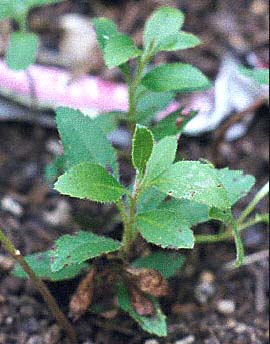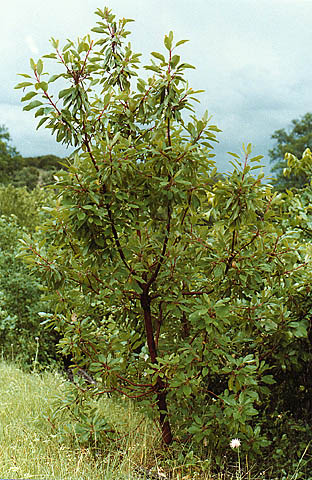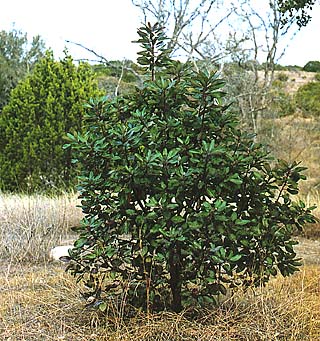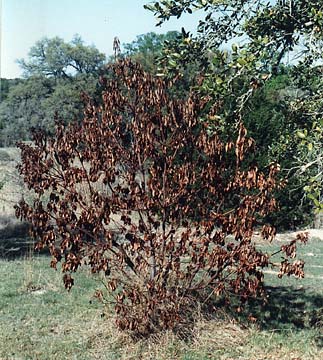

|
Germination |
|

16 months old (8 months in the ground in a carton) |

7 years / Success! |
What might constitute success? When my first madrones from seed began to take hold out in the hill country, I bragged about this to Marshal Johnston, who directed a project for reestablishing endangered species at the University of Texas back in the 70s. His reply was that if my largest madrone reached a height of 10 feet, he would buy me a steak dinner. I did get my steak dinner, but I wonder how many of the other tales of success, especially from cuttings, ever reached the 10 foot mark. Johnston's project introduced a number of small madrones onto the Capitol grounds in Austin, but to my knowledge none of these attempts succeeded.
In thirty years only 4 apparently well established trees have been lost. Three were smaller trees, 5—6 feet tall, one of which had bloomed in the spring before it died in late summer [shown below]. One was a very large 30–year old tree that had produced fruit for many years. These were all in areas with deep clay soil, and they died rather suddenly immediately following significant wet periods abruptly followed by drought. I strongly suspect that the expansion and contraction of the clay tore the fine deep roots. In my opinion any root damage at any stage is sufficient to kill madrones.

|

|
| Not a success! | |
|---|---|
My own opinions as well are based on very limited experience, under very specific hill country conditions, and thus merit the same scepticism I have for others. I began in 1977 with berries collected within 2 miles of our land, on a high hill in Blanco County (TX). [A specimen from this same stand of madrones, three years later, happened to be selected for the The University of Texas Plant Resources Center Herbarium.] At the time our place was overgrazed ranchland, with cattle still present (without our permission). The closest madrone was a half mile off, visible with a 20X scope. Once my initial seedlings matured to produce berries, small madrones began to appear in nearby juniper mulch. As of 1995 we counted almost 60 plants. More and more plants appeared. In the spring of 1999 there were roughly 200, all within 600 feet of a berry tree. By 2009 there were easily over 500 volunteers of all sizes and some quite distant from berry trees.
If you decide to attempt to grow your own madrones, your experience is likely to be a unique experience.
I strongly advise starting with seeds extracted from fresh berries in early winter and immediately planted, rather than potted plants, taking advantage of the fact that seeds readily germinate. Produce large numbers of seedlings, and then let natural selection take its course.
If you absolutely must have that large madrone by tomorrow, work closely with an established local native plant nursery. Try to get plants that have never been moved, in biodegradable containers that should be placed directly into the ground. And references documenting 5-year and 10-foot successful plantings might be in order.